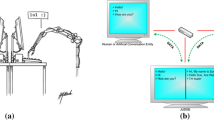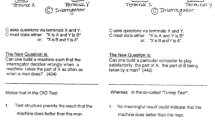Abstract
This paper considers undecidability in the imitation game, the so-called Turing Test. In the Turing Test, a human, a machine, and an interrogator are the players of the game. In our model of the Turing Test, the machine and the interrogator are formalized as Turing machines, allowing us to derive several impossibility results concerning the capabilities of the interrogator. The key issue is that the validity of the Turing test is not attributed to the capability of human or machine, but rather to the capability of the interrogator. In particular, it is shown that no Turing machine can be a perfect interrogator. We also discuss meta-imitation game and imitation game with analog interfaces where both the imitator and the interrogator are mimicked by continuous dynamical systems.
Similar content being viewed by others
References
Anderlini, L. (1990), 'Some Notes on Church's Thesis and the Theory of Games', Theory and Decision 29, pp. 19–52.
Blum, L., Cucker, F., Shub, M. and Smale, S. (1998), Complexity and Real Computation, New York: Springer-Verlag.
Bradford, P.G. and Wollowski, M. (1993), 'A Formalization of the Turing Test', Proceedings of 5th Midwest Artificial Intelligence and Cognitive Science Conference, pp. 83–87.
Campagnolo, M.L., Moore, C. and Costa, J.F. (2000), 'Iteration, Inequalities, and Differentiability in Analog Computers', Journal of Complexity 16(4), pp. 642–660.
Crutchfield, J.P. (1998), 'Dynamical Embodiment of Computation in Cognitive Processes', Behavioral and Brain Sciences 21(5), pp. 635–637.
Crutchfield, J.P. and Young, K. (1989), 'Inferring Statistical Complexity', Physical Review Letters 63, pp. 105–108.
Dowling, W.F. (1990), 'Computer Viruses: Diagonalization and Fixed Points', Notice of the AMS 37, pp. 858–861.
Forner, L. (1997), 'Entertaining Agents: A Sociological Case Study', Proceedings of International Conference on Autonomous Agents 97, pp. 122–129.
French, R.M. (2000), 'The Turing Test: The First Fifty Years', Trends in Cognitive Sciences 4(3), pp. 115–121.
Harnad, S. (1990), 'The Symbol Grounding Problem', Physica D 42, pp. 335–346.
Harnad, S. (2001), 'Minds, Machines, and Turing: The Indistinguishability of Indistinguishables', Journal of Logic, Language, and Information 9(4), pp. 425–445.
Hofstadter, D.R. and Dennett, D.C. (1981), The Mind's I, Basic Books.
Mauldin, M. (1994), 'Chatterbots, Tiny MUDs, and the Turing Test', Proceedings of National Conference of Artificial Intelligence 94, pp. 16–21.
Moore, C. (1990), 'Unpredictability and Undecidability in Dynamical Systems', Physical Review Letters 64, pp. 2354–2357.
Moore, C. (1998), 'Dynamical Recognizers: Real-Time Language Recognition by Analog Computers', Theoretical Computer Science 201, pp. 99–136.
Pollack, J.B. (1991), 'The Induction of Dynamical Recognizers', Machine Learning 7, pp. 227–252.
Pour-El, M.B. and Richards, J.I. (1989), 'Computability in Analysis and Physics', Berlin: Springer-Verlag.
Premack, D. and Woodruff, G. (1978), 'Does the Chimpanzee Have a Theory of Mind?', Behavioral and Brain Sciences 1, pp. 516–526.
Rice, H.G. (1953), 'Classes of Recursively Enumerable Sets and Their Decision Problem', AMS 89, pp. 25–59.
Sato, Y. and Ikegami, T. (1999), 'Undecidability of the Imitation Game', Proceedings of Symposium on Imitation in Animals and Artifacts, pp. 157–159.
Sato, Y., Taiji, M. and Ikegami, T. (2001), 'Computation with Switching Map Systems: Nonlinearity and Computational Complexity', Santa Fe Institute working paper, WP01–12–083.
Searle, J.R. (1980), 'Minds, Brains, and Programs', Behavioral and Brain Sciences 3, pp. 417–424.
Siegelmann, H.T. (1999), Neural Networks and Analog Computation, Boston: Birkhauser.
Turing, A.M. (1936), 'On Computable Numbers, with an Application to the Enentscheidungsproblem', Proceedings of the London Mathematical Society 2(42), pp. 230–265.
Turing, A.M. (1948), 'Intelligent Machinery', in B. Meltzer and D. Michie, eds., National Physical Laboratory Report, Machine Intelligence 5, pp. 3–23, 1969.
Turing, A.M. (1950), 'Computing Machinery and Intelligence', Mind 59(236), pp. 433–460.
Tversky, A. and Kahneman, D. (1974), 'Judgement under Uncertainty: Heuristics and Biases', Science 185, pp. 1124–1131.
van Gelder, T. (1998), 'The Dynamical Hypothesis in Cognitive Science', Behavioral and Brain Science 21, pp. 1–14.
Wagenaar, W.A. (1972), 'Generation of Random Sequences by Human Subjects: A Critical Survey of Literature', Psychological Bulletin 77, pp. 65–72.
Watt, S.N.K. (1996), 'Naive Psychology and the Inverse Turing Test', Psycholoquy 14(7), p. 1.
Weizenbaum, J. (1966), 'ELIZA — A Computer Program for the Study of Natural Language Communication Between Man and Machine', Communication of the ACM 9, pp. 36–45.
Author information
Authors and Affiliations
Rights and permissions
About this article
Cite this article
Sato, Y., Ikegami, T. Undecidability in the Imitation Game. Minds and Machines 14, 133–143 (2004). https://doi.org/10.1023/B:MIND.0000021747.28850.16
Issue Date:
DOI: https://doi.org/10.1023/B:MIND.0000021747.28850.16




